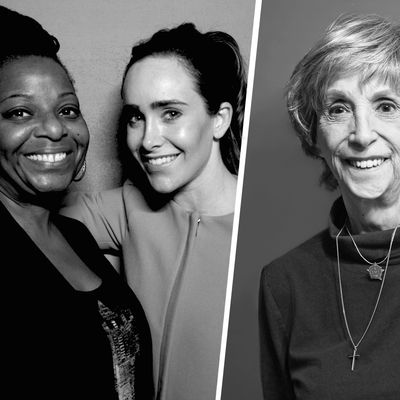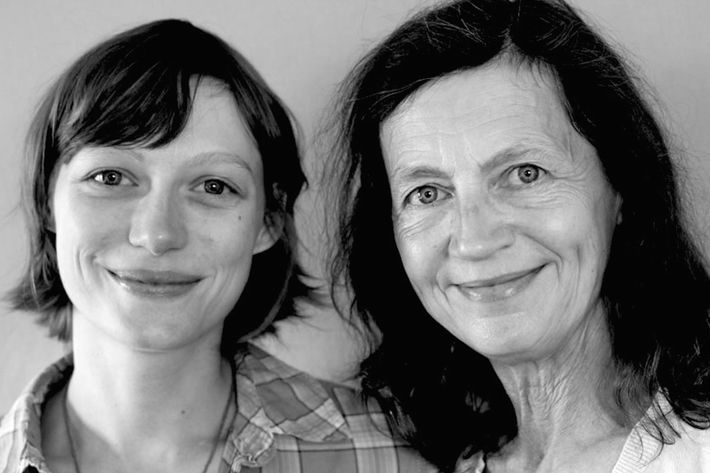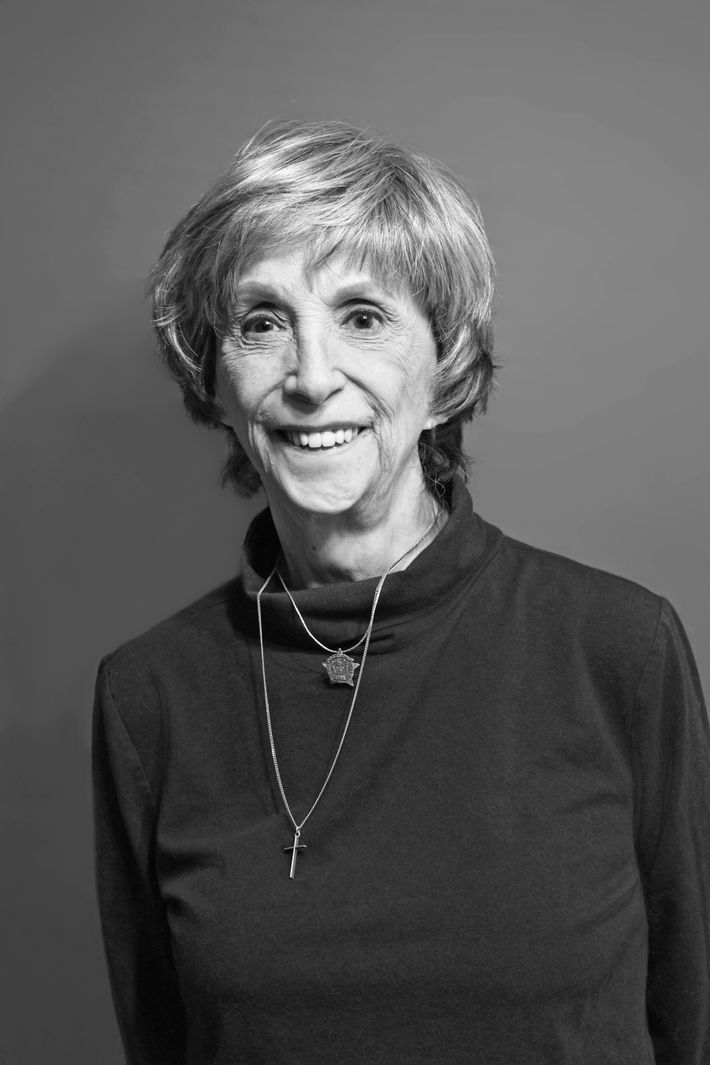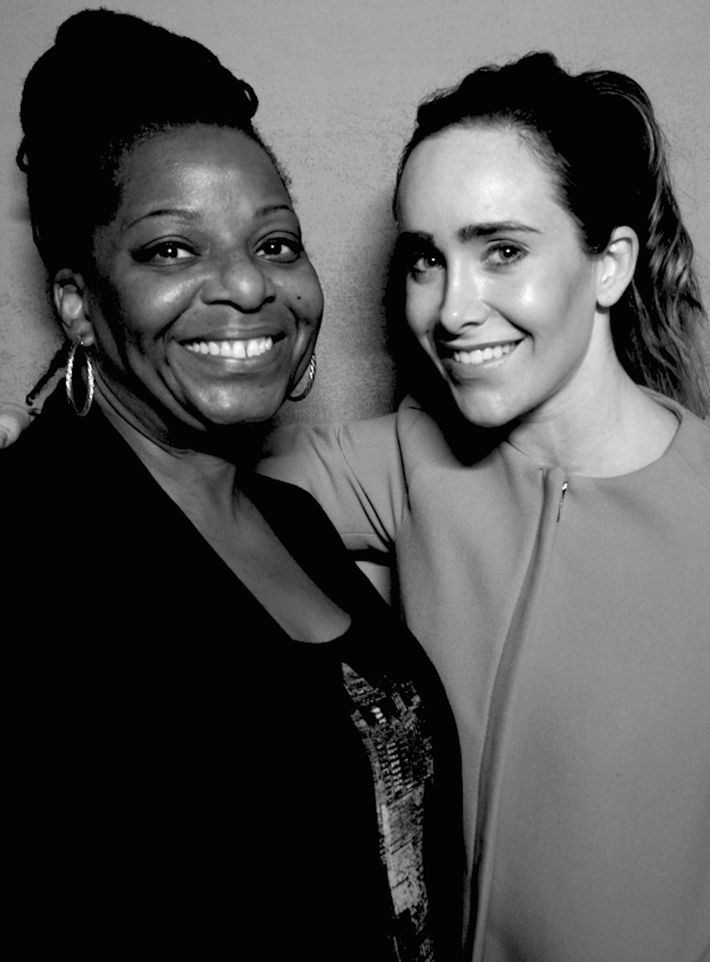
The following conversations with a bricklayer, policewoman, and New York subway conductor are excerpted from Callings: The Purpose and Passion of Work (A StoryCorps Book).
What It’s Like to Be a Woman Bricklayer
62-year-old bricklayer Barbara Moore in conversation with her 33-year-old daughter, Olivia June Fite, recorded in Baltimore, Maryland, on July 20, 2014.

When I was in high school I thought I was going to be a teacher, but there was no money for college. So right out of high school I worked in an office — but a couple of hours behind a desk and I was falling asleep. I had many, many jobs by the time I turned twenty-one. And then I started looking into the bricklayers’ apprenticeship program.
An apprentice in the bricklayers’ union started making $3.50 an hour — twice as much as I was making — and bricklayers were making $8.50 an hour! It seemed like an awful lot of money to me. And I wanted it. When I got anywhere near the bricklayers’ office, I would stop by and say, “How’s my application doing?” And at some point I guess they realized I wasn’t going away.
My mother was very afraid for me, because she thought I was going to get hurt. I think my father, like most men, doubted that I could actually do it, but that didn’t stop him from asking me to do masonry repairs on his house.
Because most of the guys were bigger than me, I would always volunteer to work in these really tight areas. It helped me hone my skills — and because I was willing to do that, the other guys would say, “I’ll take that corner with the heavy block.” So it was a good trade-off.
I remember in the first or second year of my apprenticeship, I was working with this guy Tony. He was a World War II vet who had a metal plate in his head from the war. I think he had a daughter about my age, so he kind of took a liking to me. He was a really old-school guy, but he was willing to work with me when a lot of other people did not want me as their partner. And he taught me everything he knew. That meant a lot, because having a woman on the job was something he probably couldn’t even imagine previous to that.
When he passed away, his daughter called me and said that he wanted to leave me his tools, and I went out and picked them up. If you’re getting tools from the bricklayers that have gone before you, that’s a sign of respect.
When I was pregnant, my midwife told me that I could do whatever I normally did, and since I normally laid brick, I continued to do that until my eighth month. When I was laying block, I couldn’t run off the scaffold every time I got morning sickness — I would have gotten fired. So I would just throw up inside the block and keep working. Worse things have gone in those blocks than my vomit, believe me.
One of Chicago’s First Policewomen on Working in the Rape Unit
74-year-old policewoman Pat Hays, recorded in Chicago, Illinois, on February 4, 2015.

When I was a kid, I was very, very shy. My dad used to come home drunk and just hit me.
I left home at seventeen, and I married my high school sweetheart — well, my sort-of sweetheart. I dropped out of high school to marry him, and I got pregnant within the month. So I went from my father’s home to my husband’s home, and I had my daughter ten months later.
My husband wasn’t working, so I went out and got a job working the switchboard at a hospital. He felt that it was OK for him to conclude arguments by hitting me, so, of course, he did. But I was not going to repeat my mother’s life, and told him, “I’m not going to take this.” I called the police, and that was it.
I worked the switchboard for a few more years. Then one day, when I was about 24, my friend told me she was going to take the Chicago policewoman’s exam. They were revamping the department, and they had formed a new unit for policewomen. And so I said, “Well, I’ll go with you and take it, too.”
Over a thousand women took that test, and from that, 219 names were posted — and we got the call to show up.
You had to be five foot three, and you had to be over 110 pounds. But I was only about five foot one; I had a crick in my neck the whole day from looking up to make conversation with people. I mean, these women were huge! But the guy who was measuring us just told me, “Stand on your toes.” And he passed me. I had no experience whatsoever, and I never really wanted to be a policewoman, but I guess I’m stubborn. I was just like, “I’m going to finish this academy if it kills me!”
I was in the class of 35 women who came on the job in 1966. Our uniform was a navy skirt with a little box jacket and this ridiculous hat that was shaped like a sugar scoop. It didn’t matter how many bobby pins you used; the damn hat would lift up in the wind and go trailing down the street.
As policewomen, our duties were mostly in youth division: family investigations of abuse or neglect. Or, with a woman victim or offender, homicides and sex crimes. We would do on-the-street arrests of truants and school absentees and curfew violators. If they found a lost child, then they would call the women in, because the men really didn’t want to deal with the children anyway.
I was assigned to what was believed to be the worst area, which was Maxwell Street. We would get runaways every day with allegations of neglect or abuse. And of course, when we found them, we would have to do a certain amount of counseling. That was an interest of mine, especially coming from a dysfunctional family. I wanted to be somebody who was warm and who you could sit and feel comfortable talking to.
I was dressed for the role as an authority figure: you’re wearing the uniform, you’ve got that big star on your chest, and you’ve got the gun on. And there’s a certain power that comes along with that costume. But I also had to find a way to get past the star and the uniform and all of that, to communicate, “What can we do here?”
I bounced around to different assignments, and I was a detective twice — first in vice, then in the rape unit. And there was always this implicit, “You must be screwing somebody to get a good job like this.” But that wasn’t true. It never was true.
I didn’t want my daughters to join the force, because I didn’t want them to have to put up with the things that I did or see the things that I saw. And I really didn’t want them to see the world from that point of view. You know, this job has got a really high divorce rate. By the time the 35 of us policewomen were on the job ten years, I would say that probably every single one of us had divorced. It’s very hard on marriages, because saying “I’m going to put you in prison for ten years for rape,” then going home and telling my husband “What would you like for dinner, dear?” — it just doesn’t go well.
I retired in 2001, but in the 34 years I was on the force, it wasn’t all adversity or I would have been really stupid to have kept that job. It’s kind of a calling. I really enjoyed helping people. I would have done it forever.
The New York Subway Conductor Who Studied Fashion
55-year-old subway conductor Paquita Williams in conversation with 28-year-old passenger Laura Lane, recorded in New York, New York, on October 7, 2013.

I was born in New York City, in Queens, the second of eight children. I grew up thinking I was going to be a famous fashion designer. I graduated from high school and I went on to FIT and studied patternmaking. I worked with a big designer and I worked in a lot of sample rooms, so I really thought I was going to be in that arena. Because at FIT, they just set you up to believe you’re going to be the next big thing — there was no limit. But then when the season finished, I would be out of a job.
About ten years ago, I took a test for the city jobs. Maybe three or four years later, they called me, and I went to Transit. It was a good opportunity: it gave me job security, and I was able to pay my bills. So I started off as a token booth clerk. And then in February of 2001, I was hired as a conductor, and my first job was on the F line. You’d have people that would stand at the same door every single day, so sometimes I’d see the same people riding in my train. And then I really started noticing them. They would see me and say, “Good morning, hi!” And I realized, People know me because I’m the conductor. I remember the first day I had stopped smoking; it was rough. But I had people on the train coming back the next day: “How you doing with the cigarettes?” And that makes my day better.
Once we had just left Fifty-Ninth Street when — we found out later — the power went out. There was no power on the tracks, north or south. So as a conductor, I have my announcement that I make through the train on the public announcement system: “Ladies and gentlemen, we’re being held momentarily. The train operator’s checking things out at this time; hopefully we’ll be moving shortly.”
But after a while, I knew somebody would be nervous. Passengers get a little antsy when you don’t see anyone in authority and don’t know what’s going on. So I put on my bright orange vest and opened my cab door to just let the people know, I’m here. I walked through the whole train from front to back and just calmed people down. About twenty years ago, I went to the dentist, and I was so afraid. And I said to the dentist, “Please, please, hold my hand. Just let me know you’re there.” And he said to me, “No, I’m not your date.”
That stuck with me, and that’s the reason I do what I do with my passengers. When you get on my train and something’s going on, I want you to know that I’m not running off without you. I’m putting on my orange vest and letting you know that if you need me to hold your hand, I’m right there.
*These interviews have been condensed and edited.
From CALLINGS: The Purpose and Passion of Work by Dave Isay. Reprinted by arrangement of Penguin Press, part of the Penguin Random House company. Copyright (c) 2016 by Dave Isay.




